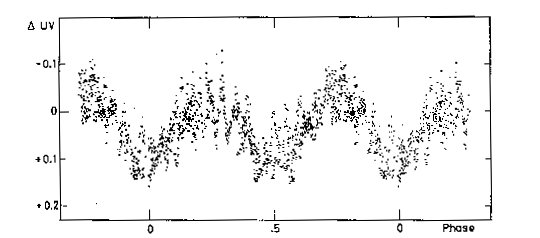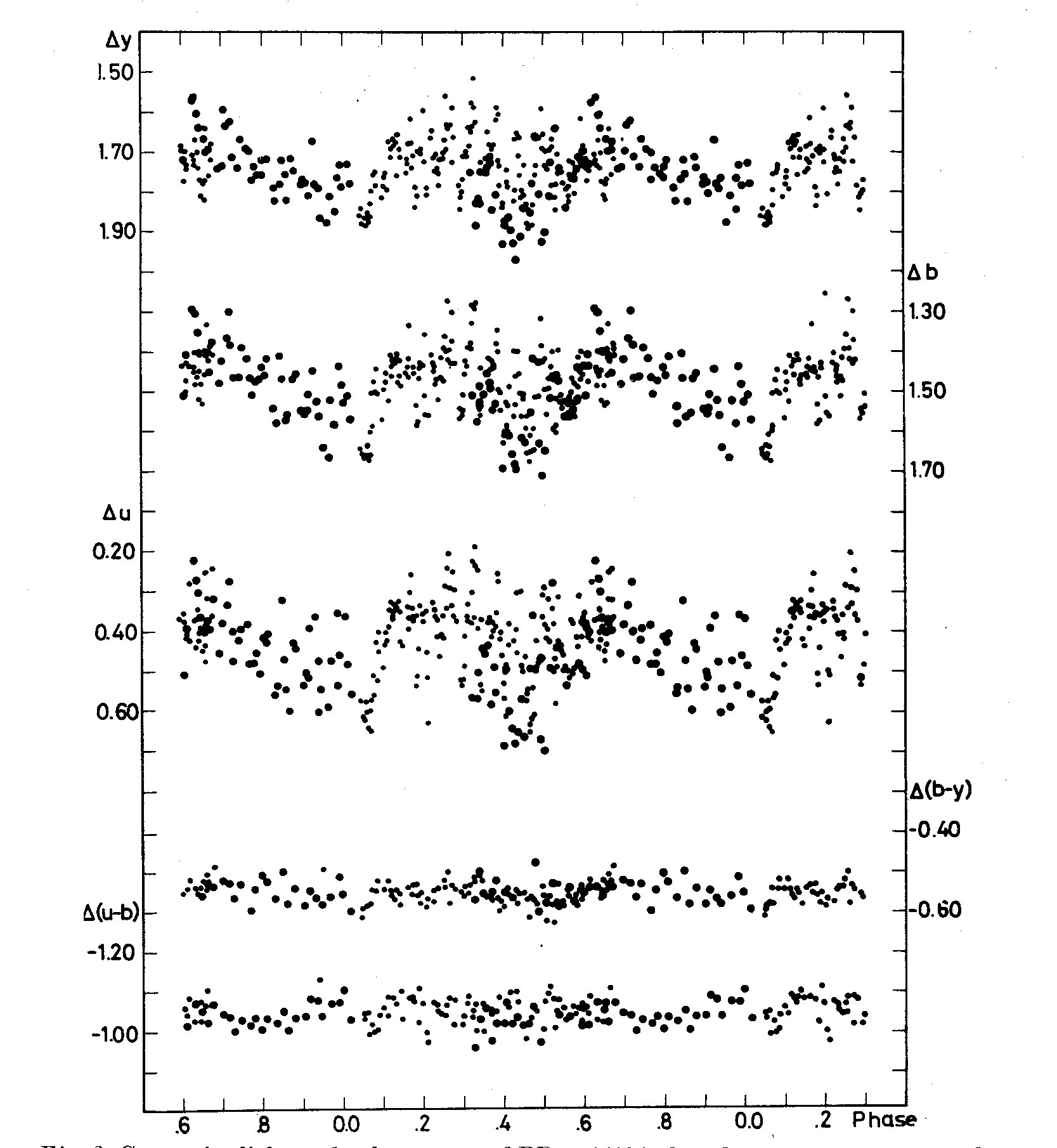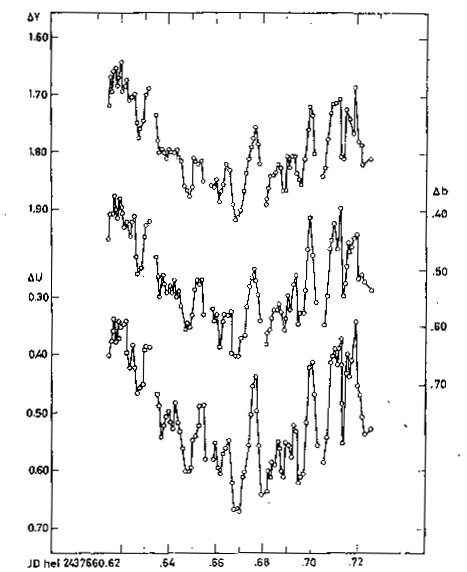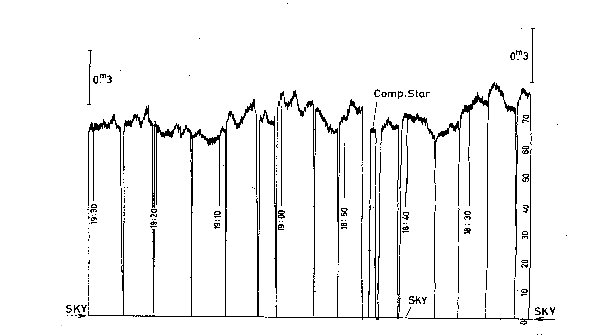Non-Periodic Phenomena in Variable Stars
IAU Colloquium, Budapest, 1968
PHOTOMETRIC OBSERVATIONS
OF THE PECULIAR BLUE VARIABLE TT ARI = BD +14 341
J. SMAK
Institute of Astronomy, Polish Academy of Sciences, Warsaw, Poland
and
K. STEPIEN
Warsaw University Observatory, Warsaw, Poland
ABSTRACT
Light variations of BD +14 341 can be resolved into three, apparently
independent activities: (1) periodic variations with P = 0.2658d and an
amplitude of about 0.15 mag.; (2) quasi-periodic fluctuations with
periods between 14 and 20 minutes and variable amplitude; and (3) small-scale,
apparently irregular fluctuations ("flickering") with a time-scale of
the order of 1 min. It is suggested that the star is a hot, subluminous close
binary system.
BD +14 341 = BV 150 Ari = TT Ari was discovered to be a variable
star by Strohmeier, Kippenhahn, and Geyer (1957). Their photographic
observations, together with those by Huth (1960), seemed to indicate
that the light variations were of irregular character. Herbig (1961)
took several spectrograms of the star (dispersions from 430 A/mm to 16
A/mm) and found that its spectrum was essentially featureless with very
weak and diffuse emission lines of the Balmer series. This indicated
that the star could be a hot, subluminous object of the nova-like type.
Following Dr. Herbig's suggestion the star was observed photoelectrically
(by J. S.) with the Crossley reflector of the Lick Observatory during the
1961/62 season. Later on additional photoelectric data were collected in 1966
with the 60 cm reflector of the Haute Provence Observatory (by J. S.) and
in 1966-68 with the 24-inch reflector of the Lick Observatory (by K. S.).
Altogether over 3000 measurements were made (mostly in ultraviolet). The aim
of the present note is to discuss the results of these observations.
 Fig. 1. Composite light curve of BD +14 341 based on measurements made
in ultraviolet light on four consecutive nights in September 1966 with
the 60 cm reflector of the Haute Provence Observatory. Phases were
computed with P = 0.2658d. Magnitude differences are plotted with an
arbitrary zero-point. The large scatter of points is due to quasi
periodic fluctuations discussed in the text.
Fig. 1. Composite light curve of BD +14 341 based on measurements made
in ultraviolet light on four consecutive nights in September 1966 with
the 60 cm reflector of the Haute Provence Observatory. Phases were
computed with P = 0.2658d. Magnitude differences are plotted with an
arbitrary zero-point. The large scatter of points is due to quasi
periodic fluctuations discussed in the text.
 Fig. 2. Composite light and color curves of BD +14 341 based on
measurements made on two nights in October 1967 with the 24-inch
reflector of the Lick Observatory. All differences are in the sense:
BD +14 341 - BD +14 336, and are left in the instrumental system.
Three, apparently independent components are present in the observed
light variations:
(1) Periodic variations with P = 0.1329d (i.e. about 3^h12^m). The shape
of the light curve is approximately that of a sine-wave. For reasons
given below we shall assume that the fundamental period is twice that
given above, i.e. P = 0.2658d. Under this assumption we have a double
sine-wave light curve (Fig. 1) with two nearly identical minima and two
only slightly different maxima; it should be made clear, however, that
these differences may not be real. The mean brightness of the star varies
from night to night by a few tenths of a magnitude (mean V = 10.6),
but the period and the shape of the light curve are very stable. The amplitude
of the periodic variations is of about 0.15 mag. Three color observations
(Fig. 2) seem to suggest that the star is slightly bluer at maxima.
Unfortunately, there is a large scatter of observations connected with the
quasi-periodic fluctuations discussed under (2). Because of that scatter it is
practically impossible to discuss the periodic variations in a more
quantitative way.
Fig. 2. Composite light and color curves of BD +14 341 based on
measurements made on two nights in October 1967 with the 24-inch
reflector of the Lick Observatory. All differences are in the sense:
BD +14 341 - BD +14 336, and are left in the instrumental system.
Three, apparently independent components are present in the observed
light variations:
(1) Periodic variations with P = 0.1329d (i.e. about 3^h12^m). The shape
of the light curve is approximately that of a sine-wave. For reasons
given below we shall assume that the fundamental period is twice that
given above, i.e. P = 0.2658d. Under this assumption we have a double
sine-wave light curve (Fig. 1) with two nearly identical minima and two
only slightly different maxima; it should be made clear, however, that
these differences may not be real. The mean brightness of the star varies
from night to night by a few tenths of a magnitude (mean V = 10.6),
but the period and the shape of the light curve are very stable. The amplitude
of the periodic variations is of about 0.15 mag. Three color observations
(Fig. 2) seem to suggest that the star is slightly bluer at maxima.
Unfortunately, there is a large scatter of observations connected with the
quasi-periodic fluctuations discussed under (2). Because of that scatter it is
practically impossible to discuss the periodic variations in a more
quantitative way.
 Fig. 3. Three-color observations of BD +14 341 made on Dec. 28 UT, 1961
with the Crossley reflector. The magnitude differences are in the sense:
BD +14 341 - BD + 14 336, and are left in the instrumental system.
(2) Quasi-periodic fluctuations with periods between 14 and 20 minutes.
Their amplitude can be as large as 0.2 mag. Williams (1966) made a statistical
analysis of one of our photoelectric runs and concluded that this quasi-periodicity
was a transient phenomenon and that two predominant periodicities were present
of about 14 and 18 minutes. On the basis of the entire material now available
one can make the following conclusions: (a) the quasi-periodicity comes and goes
without any obvious regularity and usually lasts no longer than about 3 hours;
(b) the amplitude of these variations is larger when the
quasi-periodicity is more pronounced; (c) the star is bluer at maxima,
i.e. the amplitude of the quasi-periodic fluctuations is the largest in
the ultraviolet and the smallest in the yellow (see Fig. 3). The colors
vary between B-V = -0.06 and -0.08 and U-B = - 0.92 and -0.97. This
places the star close to the black body line in the two-color diagram
with T_e between 15 000 K and 16 000 K.
(3) Irregular fluctuations ("flickering"), which are observed in many
novae and nova-like objects. The amplitude of this flickering is up to
0.1 mag. and its time-scale is of the order of 1 min. (see Fig. 4).
Fig. 3. Three-color observations of BD +14 341 made on Dec. 28 UT, 1961
with the Crossley reflector. The magnitude differences are in the sense:
BD +14 341 - BD + 14 336, and are left in the instrumental system.
(2) Quasi-periodic fluctuations with periods between 14 and 20 minutes.
Their amplitude can be as large as 0.2 mag. Williams (1966) made a statistical
analysis of one of our photoelectric runs and concluded that this quasi-periodicity
was a transient phenomenon and that two predominant periodicities were present
of about 14 and 18 minutes. On the basis of the entire material now available
one can make the following conclusions: (a) the quasi-periodicity comes and goes
without any obvious regularity and usually lasts no longer than about 3 hours;
(b) the amplitude of these variations is larger when the
quasi-periodicity is more pronounced; (c) the star is bluer at maxima,
i.e. the amplitude of the quasi-periodic fluctuations is the largest in
the ultraviolet and the smallest in the yellow (see Fig. 3). The colors
vary between B-V = -0.06 and -0.08 and U-B = - 0.92 and -0.97. This
places the star close to the black body line in the two-color diagram
with T_e between 15 000 K and 16 000 K.
(3) Irregular fluctuations ("flickering"), which are observed in many
novae and nova-like objects. The amplitude of this flickering is up to
0.1 mag. and its time-scale is of the order of 1 min. (see Fig. 4).
 Fig. 4. Section of Brown recorder sheet showing observations of BD +14 341
in ultraviolet light made on Dec. 31 UT, 1961 with the Crossley reflector.
Short-period fluctuations ("flickering") are clearly visible.
As a working hypothesis we suggest the following interpretation of the
observational data. BD +14 341 is a close binary system with the
orbital period P = 0.2658d. Regular light variations connected with this
period are due to the aspherical shape of either one or both components.
Quasi-periodic variations with periods between 14 and 20 minutes are due
to pulsations of either one or both components, as suggested by Williams
(1966). We believe, however, that in the case of a three-axial ellipsoid
the situation should be much more complicated than that considered by
Williams; in particular, non-radial pulsations should be present and
since no appropriate theory is now available we can only conclude that
the resulting light variations could indeed be rather complicated.
REFERENCES
Herbig, G. H., 1961, Private information.
Huth, H., 1960, Mitt. veranderl. Sterne, No. 454.
Strohmeier, W., Kippenhahn, R., and Geyer, E., 1957, Kl. Veroff. Bamberg, No. 18.
Williams, J. O., 1966, Publ. astr. Soc. Pacific 78, 279.
DISCUSSION
Lortet-Zuckermann: Did you obtain profiles of the hydrogen lines?
Herbig: If I understand the question, the Lick coude-plates of +14 341 show
only very weak emission components at the H lines; the spectrum is
otherwise continuous.
Fig. 4. Section of Brown recorder sheet showing observations of BD +14 341
in ultraviolet light made on Dec. 31 UT, 1961 with the Crossley reflector.
Short-period fluctuations ("flickering") are clearly visible.
As a working hypothesis we suggest the following interpretation of the
observational data. BD +14 341 is a close binary system with the
orbital period P = 0.2658d. Regular light variations connected with this
period are due to the aspherical shape of either one or both components.
Quasi-periodic variations with periods between 14 and 20 minutes are due
to pulsations of either one or both components, as suggested by Williams
(1966). We believe, however, that in the case of a three-axial ellipsoid
the situation should be much more complicated than that considered by
Williams; in particular, non-radial pulsations should be present and
since no appropriate theory is now available we can only conclude that
the resulting light variations could indeed be rather complicated.
REFERENCES
Herbig, G. H., 1961, Private information.
Huth, H., 1960, Mitt. veranderl. Sterne, No. 454.
Strohmeier, W., Kippenhahn, R., and Geyer, E., 1957, Kl. Veroff. Bamberg, No. 18.
Williams, J. O., 1966, Publ. astr. Soc. Pacific 78, 279.
DISCUSSION
Lortet-Zuckermann: Did you obtain profiles of the hydrogen lines?
Herbig: If I understand the question, the Lick coude-plates of +14 341 show
only very weak emission components at the H lines; the spectrum is
otherwise continuous.
 Fig. 1. Composite light curve of BD +14 341 based on measurements made
in ultraviolet light on four consecutive nights in September 1966 with
the 60 cm reflector of the Haute Provence Observatory. Phases were
computed with P = 0.2658d. Magnitude differences are plotted with an
arbitrary zero-point. The large scatter of points is due to quasi
periodic fluctuations discussed in the text.
Fig. 1. Composite light curve of BD +14 341 based on measurements made
in ultraviolet light on four consecutive nights in September 1966 with
the 60 cm reflector of the Haute Provence Observatory. Phases were
computed with P = 0.2658d. Magnitude differences are plotted with an
arbitrary zero-point. The large scatter of points is due to quasi
periodic fluctuations discussed in the text.
 Fig. 2. Composite light and color curves of BD +14 341 based on
measurements made on two nights in October 1967 with the 24-inch
reflector of the Lick Observatory. All differences are in the sense:
BD +14 341 - BD +14 336, and are left in the instrumental system.
Three, apparently independent components are present in the observed
light variations:
(1) Periodic variations with P = 0.1329d (i.e. about 3^h12^m). The shape
of the light curve is approximately that of a sine-wave. For reasons
given below we shall assume that the fundamental period is twice that
given above, i.e. P = 0.2658d. Under this assumption we have a double
sine-wave light curve (Fig. 1) with two nearly identical minima and two
only slightly different maxima; it should be made clear, however, that
these differences may not be real. The mean brightness of the star varies
from night to night by a few tenths of a magnitude (mean V = 10.6),
but the period and the shape of the light curve are very stable. The amplitude
of the periodic variations is of about 0.15 mag. Three color observations
(Fig. 2) seem to suggest that the star is slightly bluer at maxima.
Unfortunately, there is a large scatter of observations connected with the
quasi-periodic fluctuations discussed under (2). Because of that scatter it is
practically impossible to discuss the periodic variations in a more
quantitative way.
Fig. 2. Composite light and color curves of BD +14 341 based on
measurements made on two nights in October 1967 with the 24-inch
reflector of the Lick Observatory. All differences are in the sense:
BD +14 341 - BD +14 336, and are left in the instrumental system.
Three, apparently independent components are present in the observed
light variations:
(1) Periodic variations with P = 0.1329d (i.e. about 3^h12^m). The shape
of the light curve is approximately that of a sine-wave. For reasons
given below we shall assume that the fundamental period is twice that
given above, i.e. P = 0.2658d. Under this assumption we have a double
sine-wave light curve (Fig. 1) with two nearly identical minima and two
only slightly different maxima; it should be made clear, however, that
these differences may not be real. The mean brightness of the star varies
from night to night by a few tenths of a magnitude (mean V = 10.6),
but the period and the shape of the light curve are very stable. The amplitude
of the periodic variations is of about 0.15 mag. Three color observations
(Fig. 2) seem to suggest that the star is slightly bluer at maxima.
Unfortunately, there is a large scatter of observations connected with the
quasi-periodic fluctuations discussed under (2). Because of that scatter it is
practically impossible to discuss the periodic variations in a more
quantitative way.
 Fig. 3. Three-color observations of BD +14 341 made on Dec. 28 UT, 1961
with the Crossley reflector. The magnitude differences are in the sense:
BD +14 341 - BD + 14 336, and are left in the instrumental system.
(2) Quasi-periodic fluctuations with periods between 14 and 20 minutes.
Their amplitude can be as large as 0.2 mag. Williams (1966) made a statistical
analysis of one of our photoelectric runs and concluded that this quasi-periodicity
was a transient phenomenon and that two predominant periodicities were present
of about 14 and 18 minutes. On the basis of the entire material now available
one can make the following conclusions: (a) the quasi-periodicity comes and goes
without any obvious regularity and usually lasts no longer than about 3 hours;
(b) the amplitude of these variations is larger when the
quasi-periodicity is more pronounced; (c) the star is bluer at maxima,
i.e. the amplitude of the quasi-periodic fluctuations is the largest in
the ultraviolet and the smallest in the yellow (see Fig. 3). The colors
vary between B-V = -0.06 and -0.08 and U-B = - 0.92 and -0.97. This
places the star close to the black body line in the two-color diagram
with T_e between 15 000 K and 16 000 K.
(3) Irregular fluctuations ("flickering"), which are observed in many
novae and nova-like objects. The amplitude of this flickering is up to
0.1 mag. and its time-scale is of the order of 1 min. (see Fig. 4).
Fig. 3. Three-color observations of BD +14 341 made on Dec. 28 UT, 1961
with the Crossley reflector. The magnitude differences are in the sense:
BD +14 341 - BD + 14 336, and are left in the instrumental system.
(2) Quasi-periodic fluctuations with periods between 14 and 20 minutes.
Their amplitude can be as large as 0.2 mag. Williams (1966) made a statistical
analysis of one of our photoelectric runs and concluded that this quasi-periodicity
was a transient phenomenon and that two predominant periodicities were present
of about 14 and 18 minutes. On the basis of the entire material now available
one can make the following conclusions: (a) the quasi-periodicity comes and goes
without any obvious regularity and usually lasts no longer than about 3 hours;
(b) the amplitude of these variations is larger when the
quasi-periodicity is more pronounced; (c) the star is bluer at maxima,
i.e. the amplitude of the quasi-periodic fluctuations is the largest in
the ultraviolet and the smallest in the yellow (see Fig. 3). The colors
vary between B-V = -0.06 and -0.08 and U-B = - 0.92 and -0.97. This
places the star close to the black body line in the two-color diagram
with T_e between 15 000 K and 16 000 K.
(3) Irregular fluctuations ("flickering"), which are observed in many
novae and nova-like objects. The amplitude of this flickering is up to
0.1 mag. and its time-scale is of the order of 1 min. (see Fig. 4).
 Fig. 4. Section of Brown recorder sheet showing observations of BD +14 341
in ultraviolet light made on Dec. 31 UT, 1961 with the Crossley reflector.
Short-period fluctuations ("flickering") are clearly visible.
As a working hypothesis we suggest the following interpretation of the
observational data. BD +14 341 is a close binary system with the
orbital period P = 0.2658d. Regular light variations connected with this
period are due to the aspherical shape of either one or both components.
Quasi-periodic variations with periods between 14 and 20 minutes are due
to pulsations of either one or both components, as suggested by Williams
(1966). We believe, however, that in the case of a three-axial ellipsoid
the situation should be much more complicated than that considered by
Williams; in particular, non-radial pulsations should be present and
since no appropriate theory is now available we can only conclude that
the resulting light variations could indeed be rather complicated.
REFERENCES
Herbig, G. H., 1961, Private information.
Huth, H., 1960, Mitt. veranderl. Sterne, No. 454.
Strohmeier, W., Kippenhahn, R., and Geyer, E., 1957, Kl. Veroff. Bamberg, No. 18.
Williams, J. O., 1966, Publ. astr. Soc. Pacific 78, 279.
DISCUSSION
Lortet-Zuckermann: Did you obtain profiles of the hydrogen lines?
Herbig: If I understand the question, the Lick coude-plates of +14 341 show
only very weak emission components at the H lines; the spectrum is
otherwise continuous.
Fig. 4. Section of Brown recorder sheet showing observations of BD +14 341
in ultraviolet light made on Dec. 31 UT, 1961 with the Crossley reflector.
Short-period fluctuations ("flickering") are clearly visible.
As a working hypothesis we suggest the following interpretation of the
observational data. BD +14 341 is a close binary system with the
orbital period P = 0.2658d. Regular light variations connected with this
period are due to the aspherical shape of either one or both components.
Quasi-periodic variations with periods between 14 and 20 minutes are due
to pulsations of either one or both components, as suggested by Williams
(1966). We believe, however, that in the case of a three-axial ellipsoid
the situation should be much more complicated than that considered by
Williams; in particular, non-radial pulsations should be present and
since no appropriate theory is now available we can only conclude that
the resulting light variations could indeed be rather complicated.
REFERENCES
Herbig, G. H., 1961, Private information.
Huth, H., 1960, Mitt. veranderl. Sterne, No. 454.
Strohmeier, W., Kippenhahn, R., and Geyer, E., 1957, Kl. Veroff. Bamberg, No. 18.
Williams, J. O., 1966, Publ. astr. Soc. Pacific 78, 279.
DISCUSSION
Lortet-Zuckermann: Did you obtain profiles of the hydrogen lines?
Herbig: If I understand the question, the Lick coude-plates of +14 341 show
only very weak emission components at the H lines; the spectrum is
otherwise continuous.